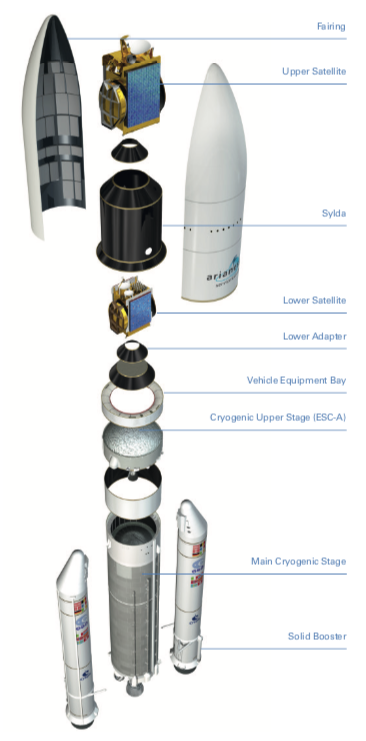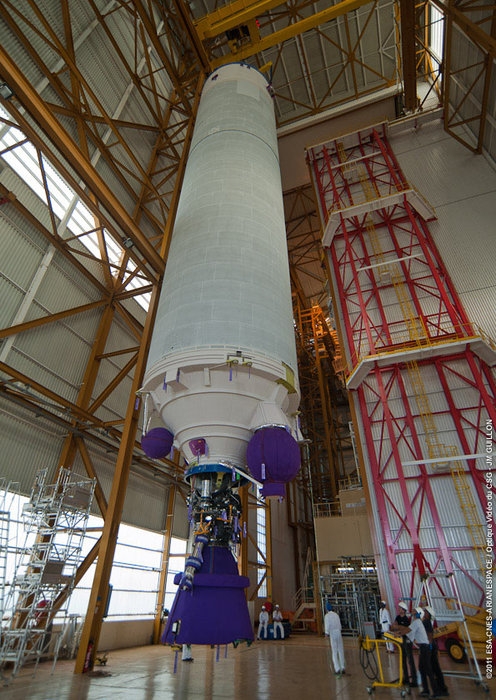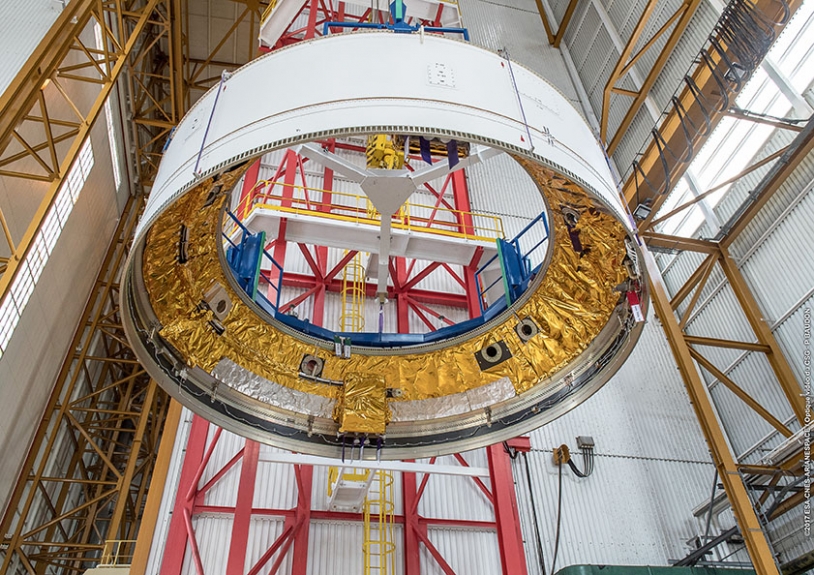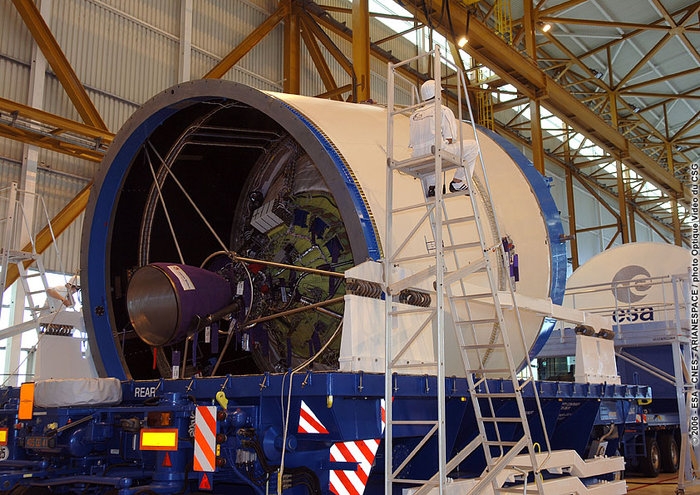Technical features
Lower composite
The lower composite comprised:
- Two EAP solid-rocket boosters each 31.6 metres tall and 3 metres in diameter, with an empty mass of 37 tonnes plus 240 tonnes of solid propellant. They delivered 7,000 kN (700 tonnes) of thrust in vacuum, just over 90% of the total thrust of the launcher at lift-off. After burning for 2 minutes and 10 seconds, the EAPs separated from the core stage 60 km above the Atlantic Ocean.
- An EPC cryogenic core stage, which burns cryogenic propellants combining liquid hydrogen and oxygen. Standing 30 metres tall, it weighed 12.5 tonnes empty and carried 174 tonnes of propellant: 149 tonnes of liquid oxygen on top and 25 tonnes of liquid hydrogen below. It operated for 9 minutes, before separating from the upper stage at an altitude of around 145 km. Its Vulcain engine, designed by Snecma Moteurs, weighed 1,650 kg and delivered 20 times more thrust than Ariane 4’s. Vulcain 2 was an upgraded version of this engine, designed for Ariane 5 ECA, providing a 20% performance gain to deliver 1,390 kN (139 tonnes) of thrust in vacuum.
Upper composite
The upper composite separated from the core stage at around 145 kilometres to impart the velocity required to inject the payload into geostationary transfer orbit (GTO). It comprised the only stage that was not ignited at lift-off. The type of stage depended on the launcher variant.
Vehicle equipment bay (VEB): this was the launcher’s electronic brain, containing all the instructions necessary for flight; it controlled and corrected the launcher’s position if needed, commanded engine cut-off, stage separation and so on. The VEB housed the telemetry instruments that kept a check on more than 1,500 parameters, including the transmitters and antennas that sent and received signals to and from tracking stations on the ground. It was also where the fairing and SYLDA—or SPELTRA on earlier versions—bearing structure were attached.
Upper stage
- For Ariane 5 ECA, the ESC cryogenic upper stage: the HM-7B engine was an upgraded version of the HM-7 engine that powered the upper stages of every launcher in the series since Ariane 1. It was developed by the Ariane 5 Plus evolution programme for the new ECA variant of the launcher. Like the core stage’s Vulcain 2 engine, it burned liquid hydrogen and oxygen. It operated for up to 15 minutes and 45 seconds, delivering 67 kN (6.7 tonnes) of thrust in vacuum.
- For the generic and ES variants of Ariane 5, the EPS storable propellant stage: the Aestus engine developed for Ariane 5 burned a mixture of liquid mono-methyl-hydrazine and nitrogen peroxide. It was much less powerful than the HM-7B, delivering 29 kN (2.9 tonnes) of thrust in vacuum, but it was reignitable and thus able to inject satellites into different orbits before falling back to Earth.
Payload
Bearing structure: when several satellites were mated atop Ariane 5, they were each held in place until reaching orbit by special bearing structures.
- The first such structure was the SPELTRA (Structure Porteuse Externe pour Lancements Triples Ariane) multiple-launch external bearing structure used for the first three launches of Ariane 5. It was located between the VEB and the fairing and housed a satellite and a short fairing to protect the satellite in the upper berth.
- The bearing structure used after that was a lighter version called SYLDA (SYstème de Lancement Double Ariane) designed for dual launches: one of the satellites was placed on top and the other inside, and both covered completely down to the VEB by a long fairing. The SYLDA structure spanned 4.6 metres and was 4.9 to 7.0 metres tall, depending on the size of the payload. It released its satellites using pyrotechnic cutters and springs to push them out in a direction perfectly parallel to the trajectory.
- For certain missions, the ASAP structure (Ariane Structure for Auxiliary Payloads) could be used to carry up to eight microsatellites. When launching the European Galileo satellites, Ariane 5 ES used another type of dispenser able to accommodate four satellites.
Fairing: Ariane 5’s fairing was made of two half-shells. Its role was to protect the payloads on ascent through the atmosphere and to make the launcher more aerodynamic. Its short version was 5.4 metres in diameter and 12 metres tall, and its long version 17 metres tall. Its structure was a sandwich composite with an aluminium honeycomb core covered by two carbon skins.
The ACY raising cylinder enabled larger payloads (maximum +1.5 metres) to be accommodated.
Three minutes into the flight, at an altitude of about 120 km, the atmosphere is a lot less dense and the fairing could be jettisoned as soon as possible to lighten the upper stage by more than 2 tonnes: the two half-shells were pulled apart by a dual pyrotechnic system and then jettisoned away from the launcher’s trajectory.

The Ariane 5 ES fairing in the final assembly building. © 2018 ESA/CNES/Arianespace/CSG video and photo department - S. Martin
Ariane 5 variants
| Launcher | Ariane 5 G | Ariane 5 G+ | Ariane 5 GS | Ariane 5 ECA (2018) | Ariane 5 ES ATV |
| Height | Up to 52 m | Up to 52 m | Up to 47 m | Up to 52 m | Up to 53 m |
| Lift-off mass | 746 t | 746 t | 750 t | 780 t | 775 t |
| Payload mass for single launch | 6,9 t (GTO1) | 6,9 t (GTO1) | 6,5 t (GTO1) | 10,8 t (GTO1) | Up to 21 t (into 300-km low Earth orbit) |
| Payload mass for dual launch | 5,9 t (GTO1) | - | 6 t (GTO1) | 10 t (GTO1) | - |
| Engine | Vulcain | Vulcain | Vulcain | Vulcain 2 | Vulcain 2 |
| Upper stage | EPS2 with Aestus engine | EPS2 with Aestus engine | EPS2 with Aestus engine | ESC-A with HM-7B engine | EPS2 with Aestus engine |
| Other modifications | - | Enhanced EPS2 performance | Enhanced EPS2 and EAP3 performance | Enhanced EAP3 performance | Adaptation du VEB (Vehicule Equipment Bay) pour l'ATV |
| First flight | 4 June 1996 (failed) | 2 March 2004 | 11 August 2005 | 11 December 2002 (failed) | 9 mars 2008 |
| Number of launches* | 16 | 3 | 6 | 84 | 8 |
* At 1 October 20123
1 Geostationary Transfer Orbit
2 Etage à Propergols Stockables - storable-propellant stage
3 Etages d'Accélération à Poudre - solid-booster stage








